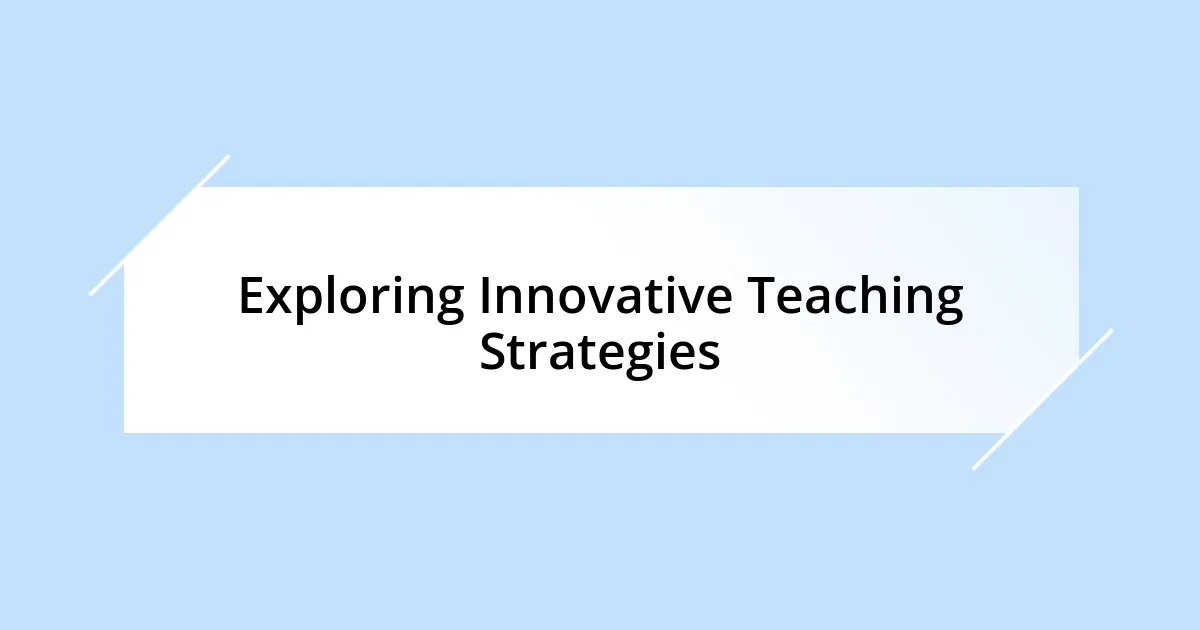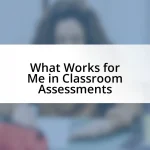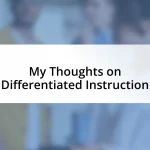Key takeaways:
- The importance of innovation in teaching is highlighted by the necessity to engage students actively and adapt to their diverse learning styles.
- Exploring new teaching strategies, such as gamification and hands-on learning, can greatly enhance student participation and understanding.
- Collaboration with fellow educators fosters creative solutions and refreshes teaching approaches, cultivating a supportive community.
- Measuring the impact of innovation through student feedback and academic performance emphasizes its role in shaping the overall learning experience.

Understanding the Need for Innovation
Understanding the need for innovation in teaching is essential, especially as our world is rapidly changing. I remember the first time I used technology in the classroom; students were not just passive recipients but active participants, eager to engage with the content. Seeing their eyes light up made me realize how crucial it is to adapt our teaching methods to keep pace with their interests and the demands of modern society.
Have you ever felt that traditional teaching methods sometimes fall flat? I certainly have. One day, while discussing a complex concept in a lecture-style format, I noticed students doodling instead of taking notes. That moment struck me—it was clear that to connect with my students, I needed to innovate my approach to foster engagement and curiosity about learning.
Reflecting on my experiences, I recognize that innovation isn’t just a buzzword; it’s a necessity. As educators, we not only prepare students for exams but also for life in a dynamic world. The more I innovate, the more I see students not only retaining information but also developing critical thinking skills and a passion for learning, which I think is the ultimate goal of education.

Identifying Personal Teaching Challenges
When I think about my teaching challenges, a few specific moments stand out. One time, I found myself struggling to engage a group of students during a particularly dry lesson on historical events. It hit me that I was so focused on delivering content that I forgot to consider my students’ perspectives. This moment of realization nudged me to dig deeper into what barriers were separating me from my students’ attentiveness.
Another challenge I continuously face is managing diverse learning styles. I remember planning a group project, thinking it would be universally engaging. However, I quickly noticed that some students thrived, while others felt lost. This experience taught me that engaging with each student’s unique way of learning is crucial. This awareness led me to innovate further, exploring different teaching methods to ensure that no one gets left behind.
Identifying my teaching challenges has been a journey, intertwining self-reflection and a genuine desire to grow. There’s an emotional depth in realizing that my students’ success hinges on my adaptability. It’s motivating to constantly seek ways to inspire them, making our classroom a dynamic, supportive space for learning.
| Teaching Challenge | Personal Experience |
|---|---|
| Engagement | Realizing I wasn’t connecting during dry lessons prompted me to innovate my approach. |
| Diverse Learning Styles | Faced struggles with group projects; it highlighted the need for varied teaching methods. |

Exploring Innovative Teaching Strategies
Delving into innovative teaching strategies, I’ve found that hands-on learning can change the dynamic in the classroom. I’ll never forget the energy in the room during a science experiment I organized; students weren’t just learning about chemistry—they were experiencing it. Their excitement bubbled over as they mixed solutions, proving that when students are involved in the process, learning becomes more impactful.
To expand my approach, I’ve explored several effective strategies that keep students engaged:
- Gamification: Integrating game-like elements can turn lessons into exciting challenges.
- Collaborative Learning: Encouraging group work fosters communication and helps students learn from one another.
- Flipped Classroom: Assigning lectures as homework allows for deeper discussion and application of concepts during class time.
- Real-World Connections: Linking lessons to current events or practical applications makes learning relevant.
- Technology Integration: Using digital tools not only boosts engagement but also prepares students for the tech-driven world they’ll enter.
In my quest to innovate, I also discovered the power of storytelling. One day, I decided to teach a complex mathematical concept through a narrative that involved characters facing relatable problems. Watching my students’ expressions shift from confusion to understanding as the story unfolded has been one of my most rewarding teaching moments. This strategy drew them in emotionally, and it reminded me that education isn’t just about facts and figures—it’s about connecting concepts to real life, making them memorable and meaningful.

Leveraging Technology in Education
In my own teaching journey, I’ve found technology to be a real game changer. For example, when I introduced an online platform for collaborative projects, I was amazed at how it transformed student interaction. Suddenly, quiet students became vocal contributors, sharing ideas and taking ownership of their work. Isn’t it fascinating how technology can level the playing field and foster inclusivity in the classroom?
I also remember a time when I utilized a virtual reality tool to take my students on a historical tour. Their eyes lit up as they “walked” through ancient civilizations, experiencing history in a way that textbooks simply can’t offer. It prompted me to ask: how can we harness technology not just to teach, but to ignite curiosity and wonder? This realization pushed me to explore more digital resources, integrating them seamlessly into my lessons to breathe life into complex topics.
Moreover, I’ve noticed that tech tools can serve as personalized learning aids; it allows students to work at their own pace. A student of mine, who often struggled with reading comprehension, began using an interactive app designed for literacy. Seeing her confidence grow as she navigated the program gave me immense joy. Could technology be the key to unlocking potential in every learner? With every positive experience, I grow more convinced that leveraging tech in education is not just a trend—it’s a necessity.

Collaborating with Fellow Educators
Collaboration with fellow educators has truly revitalized my teaching approach. I remember a brainstorming session with a colleague, where we exchanged ideas on integrating project-based learning into our curriculums. That conversation sparked a flurry of creativity; we each walked away with strategies that not only enhanced our lessons but also reignited our passion for teaching.
I’ve also realized that sharing challenges with my peers can lead to surprising solutions. When I faced difficulties engaging a particularly reserved class, I reached out to a fellow teacher who had experienced similar hurdles. Together, we crafted an intervention that transformed my classroom dynamics, allowing my students to thrive in a more collaborative environment. Isn’t it remarkable how two heads can be better than one when it comes to finding innovative teaching methods?
Often, I find that collaborative workshops can spark ideas I never would have considered on my own. During one such session, an educator shared their unique approach to integrating art into science lessons, which got me thinking creatively. This kind of interaction fosters a sense of community among teachers, reminding me that we are not alone in our mission to inspire our students. How can we continue to support each other in this journey? By embracing collaboration, I believe we can cultivate a vibrant learning atmosphere that benefits both teachers and students alike.

Measuring the Impact of Innovation
Measuring the impact of innovation in teaching can sometimes feel like trying to catch smoke with your bare hands. For me, tracking student engagement before and after the implementation of a new strategy often reveals surprising outcomes. Take, for instance, when I introduced interactive whiteboards in my lessons; I observed not only increased participation but an infectious enthusiasm that rippled through the classroom. Isn’t it incredible how tangible these changes can be?
Another way I measure impact is through student feedback. I often ask open-ended questions after a lesson, inviting my students to share their thoughts on what they enjoyed and what could improve. I remember one particular feedback session where a student expressed gratitude for the gamified elements of learning—I could see the pride in her eyes when she realized her voice mattered. This kind of insight motivates me to fine-tune my approach continually; how can we shape lessons that resonate deeply with our students’ experiences?
Lastly, I also look at academic performance as a key metric for assessing innovation. After adopting a blended learning model, I noticed a marked increase in quiz scores. It made me question: does a more personalized and flexible approach make learning more enjoyable and effective? This insight drives me to seek innovative solutions that cater to diverse learning styles, proving that the impact of innovation goes beyond just test scores—it shapes the learning journey, too.

Continuing Professional Development Opportunities
Continuing professional development opportunities can be a game changer for teachers like me. I still remember attending a summer workshop on digital pedagogy; the energy in the room was contagious! Listening to experts share cutting-edge technologies and their practical applications left me buzzing with possibilities. It felt empowering to learn new strategies that I could implement right away in my classroom.
One of my favorite experiences was a mentorship program I joined a few years back. Having an experienced educator guide me through lesson planning and classroom management was incredibly insightful. Their feedback was constructive yet supportive, and it opened my eyes to new ways of approaching lesson delivery. How often do we find ourselves stuck in our routines? That mentorship helped me break free from my comfort zone, encouraging me to try fresh ideas that improved my students’ learning experiences.
I also find value in online courses tailored to specific teaching challenges. Recently, I enrolled in a course focused on fostering inclusive classrooms. The discussions we had helped me reflect on my practices and rethink how I engage every student. Has your perspective ever shifted after learning something new? For me, those moments of realization are invaluable, reinforcing that learning never stops, even once you step into the classroom.














